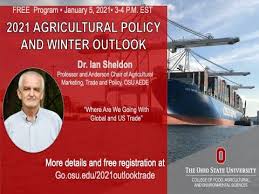Grain Marketing, Homepage Slider
Where are we going with U.S. and Global Trade?
By Dusty Sonnenberg, CCA, Ohio Field Leader: a project of the Ohio Soybean Council and soybean checkoff.
Agricultural trade was the topic of the first in a series of winter outlook meetings hosted by the Department of Agricultural, Environmental and Developmental Economics (AEDE) at The Ohio State University’s College of Food Agricultural and Environmental Sciences (FAES). Dr. Ian Sheldon, Ohio State’s Andersons Chair of Agricultural Marketing, Trade and Policy, led the discussion examining the effects of the pandemic on global trade and U.S. agricultural trade, including an evaluation of the Phase 1 Trade Agreement with China.

The COVID-19 pandemic has certainly had an impact on international trade. “Global trade was forecast to decline by 9.2% in 2020, but then rise 7.2% in 2021 according to the World Trade Organization,” said Sheldon. “Those forecasts were originally made in late October and November of 2020. Forecast estimates initially looked much worse as their April forecast was for a decline of anywhere from 13-32%.” There is still considerable uncertainty about the trajectory of trade for 2021 in light of the resurgence of COVID-19 at the end of 2020, as well as the discovery of the mutations of COVID-19 in Europe and now the United States.
The federal government’s understanding of, and response to the pandemic and international trade issues is critical. “It is important to understand the impact of the pandemic, and given the forecasts that both macroeconomic policy, be it fiscal policy or monetary policy; along with what we do or don’t do with trade policy, is quite critical to mitigate the impact of the pandemic on trade and GDP, and maybe even stimulating the economy as we come out of the pandemic,” said Sheldon. This assumes the vaccine is effective and gets widely used, not only in the U.S., but also around the world.
Data from the World Trade Organization (WTO) enhances the situational analysis. “Looking at international trade data going back to the year 2000; if the U.S. had continued on the trend for global trade prior to the financial crisis of 2008 and 2009, that global trade would have been much higher than it is today,” said Sheldon. “After the financial crisis, international trade resumed, but at a much slower pace than if we would have stayed on the trend that was set prior. The second significant disruption to international trade came with the pandemic in the spring of 2019, however it actually began to start to slow in late 2018 as global GDP slowed down. There was a close association between world trade and world industrial production looking at the third quarter of 2019.”
Looking to the future of global trade, there are several positives and negatives to weigh-out. “The resurgence of COVID-19 requiring lockdowns could reduce global GDP growth by 2-3% in 2021,” said Sheldon. “There is also uncertainty in the outlook for fiscal policy and high rates of unemployment in many countries, which could reduce trade by 4% in 2021. On the other hand, with the deployment of the approved vaccines, that could boost confidence and raise global GDP growth by 1-2%, and global trade by 3% in 2021. The trade could also be affected by growth in technology sectors, and the leveraging of information technology to allow people to work and conduct business remotely.”
In spite of the pandemic, agricultural trade has remained strong. “When the pandemic first hit, the initial posture of international agricultural trade focused on food security largely through export restrictions and stockpiling,” said Sheldon. “Some countries initiated export restrictions on corn, rice, soybeans, and wheat. Those countries placing the restrictions then removed them rather quickly.”
Agricultural trade has actually proven to be quite resilient globally. Exports started to rise by the end of May,” said Sheldon. “Global agricultural trade grew by 2% up through early December 2020. One reason is because of the essential nature of food, another is that bulk marine shipments of commodities such as cereal grains and oil seeds were not subject to major disruptions.”
The pandemic has impacted each commodity differently. “There was an increased demand for staples, processed fruits, and vegetables, largely from panic buying, and people eating at home more,” said Sheldon. “There were also reduced exports of fresh produce, dairy and meat, as well as a decline in food service demand, as well as tourism.”
An increase in food insecurity is a concern worldwide as a result of the pandemic. “By the end of 2020, an estimated 270 million people are expected to be food insecure,” said Sheldon. “This is an 82% increase from pre-pandemic levels. To help provide relief, it is critical to keep trade flows open and supply chains operational.”
Looking to the future, U.S. agricultural trade appears to be strong. “Agricultural exports are projected to be at $152 billion for 2021, which is an increase of 12% over 2020,” said Sheldon. “Soybean exports are projected to hit $26.3 billion, largely due to higher prices, strong demand from China, and record volumes. Likewise, corn exports are expected to reach 13.2 billion. Exports to China are projected to be at a record $27 billion, and they will become the largest U.S. export market for the first time since 2017.”
A video of Dr. Sheldon’s presentation can be viewed at https://aede.osu.edu/research/agricultural-policy-and-outlook-conferences/county-meetings